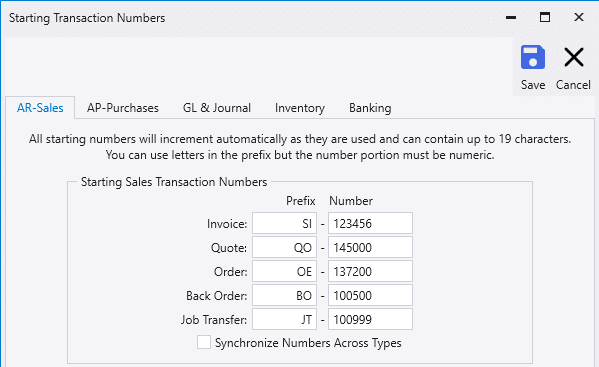Paradigm Transaction Numbering
This FAQ will explain why Paradigm increments numbers into Orders and Invoices. Paradigm assigns transaction numbers in sequential order separately for each transaction type, but retains the numbers when converting from one transaction type to another.
Starting Transaction Numbers
This can be found by going to System > Company Preferences > Transaction Numbers. This screen defines the starting number each type of transaction will use.

Transaction Numbering (Synchronize Number Across Types – Enabled)
When enabling “Synchronize Numbers Across Types”, make sure this is done after hours. Enabling this during business hours may cause transaction numbering issues.
When enabled, Paradigm will choose the next available number for quotes, orders, invoices, back orders, and job transfers, instead of each transaction type having their own starting transaction number. This will prevent cases when two unrelated orders sharing the same order number suffix (1000 shared by SI-1000 and SI1-1000).
When a new order is created, Paradigm gets the next available number from quotes, orders, invoices, back orders, and job transfers. When that order is converted to an invoice, it retains the number from the order, and adds a number after the prefix. For example, order OE-1000 is not converted to invoice SI-1001, it is converted to invoice SI1-1000. When an invoice is directly created (not converted), Paradigm assigns the invoice number based on the next available number, which would be SI-1001 if OE-1000 already exists.

Transaction Numbering (Synchronize Number Across Types – Disabled)
When a new order is created, Paradigm grabs the next available order number. When that order is converted to an invoice, it retains the number from the order, and adds a number after the prefix. For example, order OE-1000 is not converted to invoice SI-1001, it is converted to invoice SI1-1000. When an invoice is directly created (not converted), Paradigm assigns the invoice number based on the next available invoice number, which could be SI-1000. This results in two unrelated orders sharing the same order number suffix (1000 shared by SI-1000 and SI1-1000), but makes it so the same number is used for all transactions converted off of the original.

Contents
Categories
- Purchase Order and Vendors (19)
- Production (34)
- Order Entry and Customers (75)
- NEW! (6)
- Job Costing (16)
- Inventory and Pricing (92)
- General (54)
- Fulfillment Pro (29)
- Dispatching (23)
- Administration and Setup (39)
- Add-Ons and Integrations (29)
- Accounting (51)
